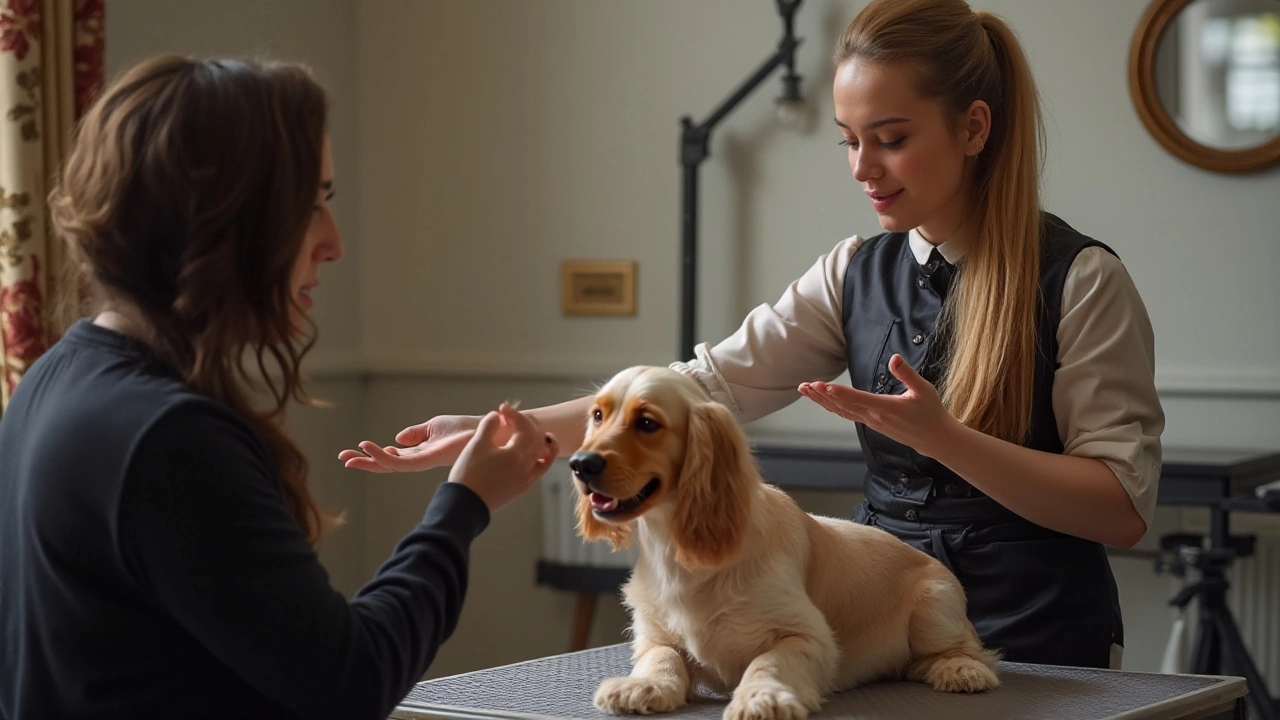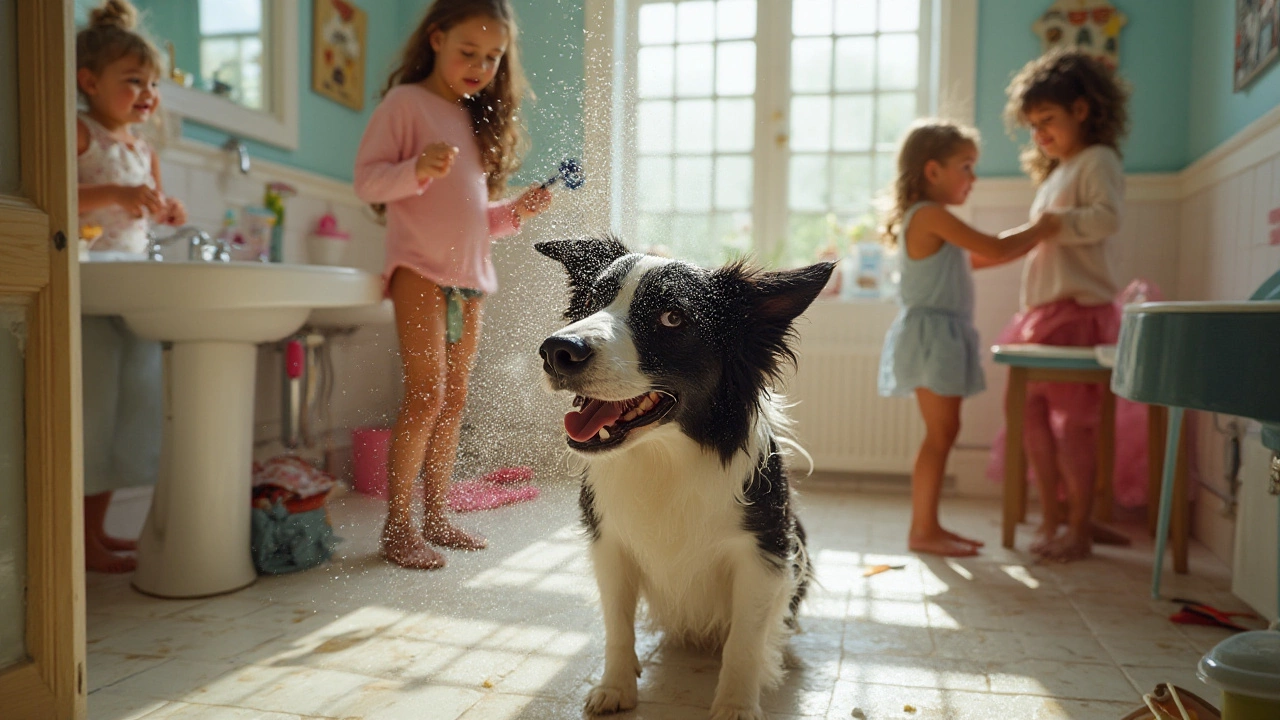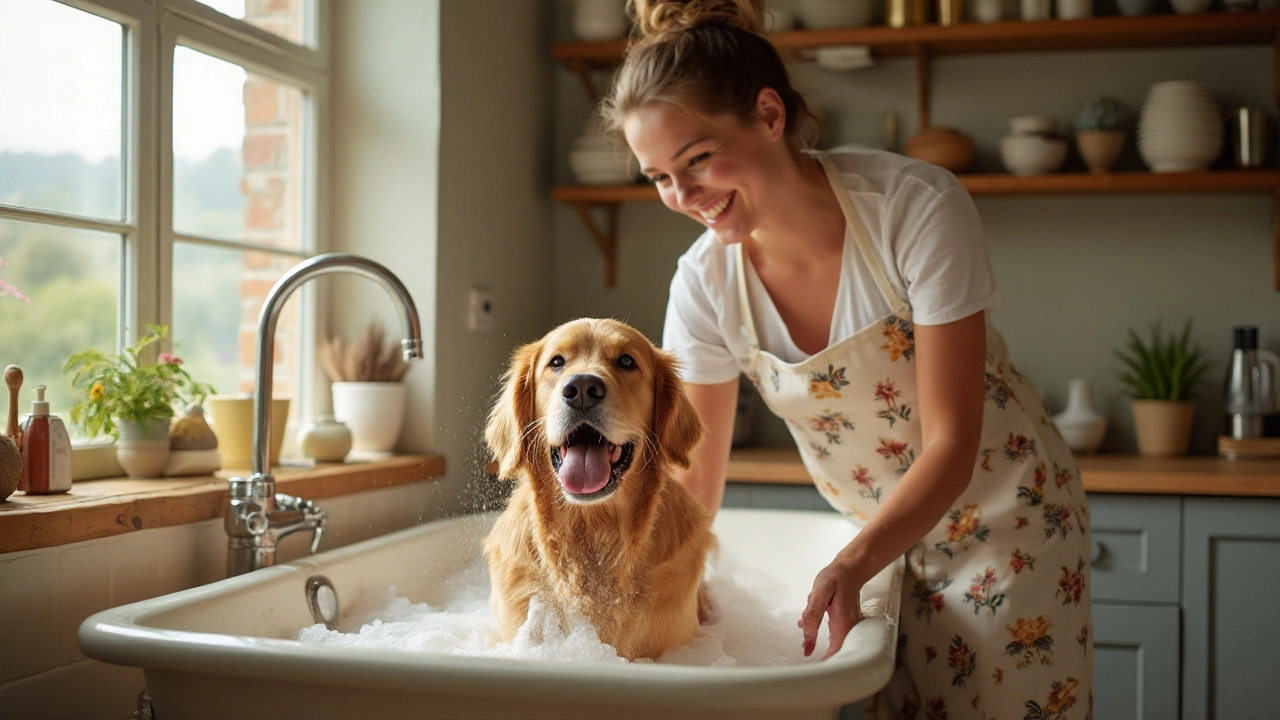Bathing your dog before grooming might seem like an extra step, but it holds significant benefits for both the pet and the groomer. Many pet owners wonder whether to bathe their furry friends before the groomer takes over, or if it’s best left as a surprise at the parlour. Yet, understanding the advantages of a fresh bath can make the grooming process smoother and more effective.
Imagine tackling a thick, tangled coat that hasn't had a good wash in weeks. Not only is it challenging for any groomer to work through, but it can also be uncomfortable for the dog. By giving your pet a bath before a grooming session, you're setting up the ideal conditions for a precise cut and a happier, cleaner pet.
- Importance of Pre-Grooming Baths
- Benefits for the Grooming Process
- How to Properly Bathe Your Dog
- Selecting the Right Shampoo
- Common Mistakes to Avoid
- Tips for a Stress-Free Bathing Experience
Importance of Pre-Grooming Baths
When you contemplate dressing up your pet for a grooming session, the question of bathing often takes center stage. But why is it so crucial, you may ask? Well, bathing a dog prior to grooming holds myriad benefits that ripple through the entire grooming process. It's not merely about cleanliness—although, a wash certainly captures that freshly-scrubbed scent we adore—it's a matter of health and appearance, too. A pre-grooming bath helps in removing the layers of dirt, loose fur, and unwanted scents that accumulate over time. By addressing these issues first, the coat is prepped and primed, facilitating smoother clipping and trimming. Imagine trying to cut a tangled and clumped coat; it's a task that can result in uneven lines and a less-than-perfect finish.
There's another facet to consider: skin health. Dirt and debris trapped close to the skin can cause irritation or even infection. By bathing before any cutting happens, you're allowing the bather to assess the skin's condition without obstruction, ensuring that any underlying conditions are not aggravated by the grooming process itself. After all, while we love our furry companions to look their best, their comfort and health remain paramount. Many professional groomers actually prefer that pets arrive bathed, as it saves time and allows them to focus on crafting the perfect shape and style.
"A clean dog is a happy dog—and a happy groomer's best friend," quotes renowned pet grooming expert, Margot Bailey.
Beyond practicality, there's also a psychological aspect to consider. Bathing can serve as a soothing ritual that not only calms your pet prior to a potentially stressful grooming session but also allows a bonding experience between you and your pet. Through consistent bathing, dogs become accustomed to the sensation of water and the handling that goes along with it, reducing anxiety in various situations. A dog that trusts the bathing process is often calmer on the grooming table as well. That's why it's essential to emphasize the harmony between cleanliness and the grooming ambiance, crafting a foundation where pets feel taken care of and cherished.
Benefits for the Grooming Process
When you bathe your dog before a grooming session, you are laying the groundwork for a significantly smoother experience. A clean coat is much easier to work with, allowing groomers to see their client's natural hair growth pattern more clearly. This insight helps in achieving a more symmetrical and aesthetically pleasing cut. Moreover, a dirt-free coat reduces the chance of dulling the groomer's clippers and scissors, prolonging the life of their tools and ensuring your pet gets a superior haircut.
A thorough bath also plays a crucial role in preventing matting. Mats can be particularly painful for dogs, as they pull on the skin, and a groomer may need to cut them out if they become too severe. By bathing your dog first, the water helps to loosen any existing tangles, making them easier to brush out before they have a chance to mat. Many groomers recommend regular baths to maintain a tangle-free coat, especially for breeds with longer hair.
Not only does a bath make the coat more manageable, but it also minimizes the spread of allergens and dirt during grooming. For dogs with sensitive skin or allergies, a clean start is critical to prevent irritation. Bathing removes not only grime but also any underlying allergens like pollen or other environmental elements that can exacerbate skin conditions. It’s not just about aesthetics; it’s about your canine's well-being. As noted by the American Kennel Club, cleanliness is a crucial part of overall pet care, especially for breeds prone to skin issues.
Remarkably, a 2021 survey revealed that dogs receiving regular baths before grooming tended to have a more peaceful grooming experience. Groomers have reported that pets accustomed to routine baths show less anxiety and are easier to manage on the grooming table. This lessens the stress for both the dog and the groomer, leading to a more efficient grooming process that everybody benefits from. It's fascinating how such a simple step can have widespread benefits.
"Regular baths can transform a good grooming experience into a great one," says Sarah Hill, a renowned pet grooming expert. "It’s about setting the stage for a healthy, happy pet."
Additionally, bathing acts as a primer for a successful cut by allowing you to check for any abnormalities before entrusting them to the groomer’s hands. Whether it's overlooked skin issues, bumps, or parasites, spotting these before the grooming session can save time and prevent complications. By making it part of your routine, you're not only ensuring a lasting, cleaner cut but also promoting a healthier lifestyle for your furry friend.

How to Properly Bathe Your Dog
Bathing your dog might seem like a straightforward task, yet it’s a delicate process that can influence your dog’s comfort and the effectiveness of subsequent grooming. A thorough pre-groom bath not only delivers a cleaner pet but also helps identify skin conditions early, ensuring better grooming outcomes. To start, always gather all necessary supplies before wetting your dog. This includes a suitable dog shampoo, conditioner if needed, a brush, towels, and maybe even a blower for quick drying. Keep in mind that dogs have different skin pH levels compared to humans, hence a specially formulated dog shampoo is a must to prevent skin irritation. Also, be aware of your dog's breed and coat type as this can impact your bathing routine greatly. For instance, a long-coated breed will require more attention to avoid tangles.
Before you begin, it is crucial to brush your dog’s coat thoroughly. This step is often overlooked, but it helps in removing dead hair and loosening dirt, making shampooing more effective. Then, protect your dog’s ears by placing cotton balls gently inside, preventing water from entering and causing infections. The right water temperature is a key factor — lukewarm water is generally the safest bet as it prevents shock and ensures comfort. Water pressure should be gentle, mimicking rainfall to soothe your pet. When it comes to lathering the shampoo, start from the neck and work your way to the tail, avoiding the head and face initially.
Rinsing is an essential part of the process. Shampoo residues can lead to skin allergies, so make sure to rinse thoroughly, until the water runs clear. Towel drying your dog is important to absorb most of the water, but avoid rubbing vigorously as it might encourage tangling of long hair. A high-velocity dryer can speed up drying, but it should be used with caution to avoid hot spots. Remember, practice patience and provide gentle reassurances to keep your dog at ease during the bath. As Dr. Emily Maxwell, a renowned veterinarian, once said,
“A relaxed dog is a clean dog. Ensure your furry friend associates bath time with a pleasant experience rather than a chore.”
For those interested in some specifics, here's a simple table outlining frequent errors to avoid and the correct actions to take:
| Mistake | Recommendation |
|---|---|
| Using human shampoo | Always use dog shampoo |
| Skipping pre-bath brushing | Brush thoroughly to remove debris |
| High water pressure | Use a gentle and consistent flow |
| Rushing the bath | Take time to ensure a complete rinse |
Finally, ensure the environment is warm and draft-free during winter months to prevent your pet from catching a cold post-bath. Bathing frequency depends on your dog’s lifestyle and coat, but a general rule of thumb is at least once a month for maintenance. With these steps, not only do you ensure a happy, healthy pet, but you also set the stage for a successful grooming session.
Selecting the Right Shampoo
One of the most essential parts of preparing your dog for grooming is choosing the right shampoo. With so many options available, it can be a daunting task for pet owners to zero in on the perfect product. But understanding your dog’s coat and skin type, as well as any specific needs, can simplify this decision considerably. The right shampoo not only cleanses your pet’s coat but also enhances its health and appearance, making the dog grooming process much more effective.
To start, consider the condition of your dog’s skin and coat. Dogs with dry, flaky skin or a dull coat might benefit from a moisturizing shampoo that contains natural oils and vitamins. For dogs with a healthy, shiny coat, a gentle, hypoallergenic shampoo could be ideal to maintain their natural oil balance. If your dog’s coat is prone to matting and tangles, a conditioning shampoo might save you the hassle of managing those difficult knots.
Another aspect to evaluate is your dog’s personal circumstances, such as allergies or sensitivities. Many dogs are sensitive to harsh chemicals commonly found in commercial shampoos. In such cases, opting for an all-natural product free from sulfates and parabens can prevent discomfort. A shampoo with soothing ingredients like oatmeal or aloe vera can provide relief to irritated skin, making grooming a more pleasant experience for your pooch.
“Choosing the right dog shampoo is akin to picking out a suitable skincare routine for yourself. It can make all the difference in your dog’s comfort and appearance,” says Dr. Emily Baldwin, a renowned vet and pet care specialist.
Moreover, if your dog has specific skin conditions like seborrhea or flea allergies, medicated shampoos are often necessary. However, it is always best to consult with your veterinarian before introducing a new type of medicated shampoo. Your vet can guide you towards products that would effectively treat the condition without causing additional irritation.
Finally, think about the fragrance, as it plays a double role. While the scent should be pleasant, it shouldn’t be overpowering. Dogs have a highly sensitive sense of smell, and strong fragrances could annoy or cause distress to them. Aim for mild scents that won’t linger overpoweringly yet provide a fresh, clean smell post-bath.
Here's a quick comparison of common shampoo types and their uses:
| Shampoo Type | Use |
|---|---|
| Moisturizing | Dry, flaky skin |
| Hypoallergenic | Sensitive skin |
| Medicated | Specific skin conditions |
| Deodorizing | Odor control |
Thus, the right shampoo not only meets the grooming standards but also mindfully addresses the unique needs of your dog’s coat. Remember, a well-chosen pet care product can transform what could be a challenging chore into a pleasant bonding time with your four-legged friend.

Common Mistakes to Avoid
Bathing dogs might seem like a straightforward task, yet it's surprising how easily mistakes can creep in, potentially affecting your dog's grooming session. One prevalent mistake is using the wrong type of shampoo. Human shampoo might appear suitable at a glance, but its pH balance is different, which can lead to skin irritation or dryness in dogs. Always opt for a shampoo specifically tailored for pets to maintain the natural oils on their skin, preserving their coat's health and shine.
Another common oversight is not rinsing thoroughly. Soap residue, if left on the skin, can cause itchiness and irritation, which might lead your dog to excessive scratching. This, in turn, can create bald spots and damage to their coat. It's important to make sure that all traces of shampoo are washed away with plenty of water. While spraying your dog down, ensure the water pressure isn't too high, as this might stress your pet. Instead, maintain a gentle and reassuring stream to keep the process soothing.
The absence of a regular bathing schedule is often a mistake owners don't realize they're making. While over-bathing can strip a dog's coat of necessary oils, going too long between baths can result in dirt build-up and unpleasant odors. Understanding your dog's breed, coat type, and lifestyle plays a huge role in determining the ideal bathing frequency. For instance, a dog that enjoys rolling in dirt may require more frequent baths than a less adventurous companion.
Not drying your dog properly after a bath is another easily overlooked mistake. Damp fur can become a breeding ground for bacteria and cause hotspots, particularly in dogs with dense coats. It's essential to gently towel-dry your dog, followed by a hairdryer set to a low temperature. Remember to keep the dryer moving to avoid overheating or burning their skin. Alternatively, air-drying in a warm room is a stress-free option for some dogs.
Dog grooming isn’t complete without addressing the common misunderstanding about brushing. Many pet owners neglect to brush their dog before bathing, leading to even bigger tangles and mats post-bath. Brushing helps to remove loose fur and untangle knots, allowing the shampoo to penetrate and clean effectively. A brush beforehand ensures that the grooming process is more pleasant for both the dog and the groomer.
"A clean coat is a healthy coat, and proper prep work goes a long way in maintaining it," notes Dr. Karen Becker, an established vet known for her holistic approach to pet care.
Lastly, ignoring the temperature of the water can cause distress or even shock in your furry friend. Water that is too hot or too cold can be uncomfortable or even harmful. Always test the water with your wrist to ensure it's lukewarm and comfortable. This attention to detail will help maintain a calm and enjoyable bath time for your pet. With these common mistakes corrected, your dog’s grooming experience can become a positive and productive part of regular pet care, allowing them to thrive in their own clean and comfortable skin.
Tips for a Stress-Free Bathing Experience
Helping your dog enjoy bath time, rather than dread it, can transform what can be a burden into a bonding experience. One core element is preparation. Begin by gathering all necessary supplies — shampoo, towels, a brush, and cotton balls to protect their ears. Having everything within reach can prevent those wet paw print trails across your floors as they scramble to escape. Also, ensure the water temperature is right; lukewarm is generally preferred as hot water can be scary and cold water uncomfortable. Remember, dogs are intuitive, and your stress can easily become theirs.
Many pets are not fond of the idea of getting wet, so introducing them to bath time gradually can make all the difference. Start by gently brushing your dog beforehand, which not only helps in removing loose fur and avoiding clogs in your tub but also offers them the chance to relax. During the bath, talk to your dog in a soothing voice, and stay positive. Try turning bath time into playtime by using rubber mats or toys to keep them entertained and steady.
"Bath time doesn’t need to be a chore," notes Dr. Alex Kelly, a renowned canine behaviorist. "When dogs feel at ease, they’re more likely to behave and tolerate both bathing and grooming.”
Breaking the process into smaller steps can also reduce stress. First, wet your pet thoroughly by starting from the back and working toward the head, which most dogs find less intrusive. Gently massage the shampoo down to the skin; it helps to use a shampoo made specifically for dogs to avoid irritating their skin. When rinsing, ensure that no soap residue remains as it might cause itching. Post-bath drying should be just as gentle. While toweling, avoid rough rubbing which might tangle their hair, instead pat them dry. If your dog is comfortable with it, consider using a pet-friendly blow dryer at a low heat setting.
It’s essential to establish a routine, especially for dog grooming. Most dogs thrive on knowing what to expect next. For instance, a small treat following each bath enhances their experience and future cooperation. Your aim is to associate bath time with positive outcomes, so even a short walk or play session afterward can work wonders. Try to bathe your dog when you are home for a few hours afterward, ensuring they remain warm and cozy as they dry naturally. This strategy provides them with a sense of security and gives you another opportunity for quality time together.
Lastly, avoid common pitfalls, such as bathing your dog too frequently, which can strip the oils their fur needs. For most breeds, a monthly bath suffices unless they romp through a muddy park. A good rule of thumb is to observe their smell and appearance. If a bath becomes inevitable, following these steps diligently can make the experience beneficial and joyful for both pet and owner. Enjoy the process as a pet care ritual rather than a tedious task, and you'll build a deeper connection with your furry companion.
